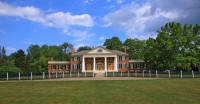 Montpelier, the Virginia estate of fourth President of the United States and Father of the Constitution James Madison, went through some tough times after his widow Dolley Madison sold it in 1844. Later owners, most prominently the du Pont family who bought it in 1901 and built on it extensively, developing it into a prominent equestrian facility. Marion du Pont Scott willed Montpelier to the National Trust for Historical Preservation upon her death in 1983. The Trust established The Montpelier Foundation, an independent non-profit organization dedicated to the management of the historic estate, and in 2003 the Foundation undertook a massive architectural restoration to return the mansion to the condition it was in when Madison retired there after the end of his second term as president in 1817.
Montpelier, the Virginia estate of fourth President of the United States and Father of the Constitution James Madison, went through some tough times after his widow Dolley Madison sold it in 1844. Later owners, most prominently the du Pont family who bought it in 1901 and built on it extensively, developing it into a prominent equestrian facility. Marion du Pont Scott willed Montpelier to the National Trust for Historical Preservation upon her death in 1983. The Trust established The Montpelier Foundation, an independent non-profit organization dedicated to the management of the historic estate, and in 2003 the Foundation undertook a massive architectural restoration to return the mansion to the condition it was in when Madison retired there after the end of his second term as president in 1817.
 The restoration was officially concluded on Constitution Day, September 17th, 2008, and was celebrated as one of the most ambitious, authentic restorations ever done in the United States. That was just the beginning, however. There was still a great deal more to be done to return the estate to its historical condition. James and Dolley Madison’s original furnishings were long gone, sold under the financial duress of Dolley’s widowhood or dispersed through the family and then out into the market. There are more Montpelier pieces in museums and private collections scattered around the country than there are in the historic mansion.
The restoration was officially concluded on Constitution Day, September 17th, 2008, and was celebrated as one of the most ambitious, authentic restorations ever done in the United States. That was just the beginning, however. There was still a great deal more to be done to return the estate to its historical condition. James and Dolley Madison’s original furnishings were long gone, sold under the financial duress of Dolley’s widowhood or dispersed through the family and then out into the market. There are more Montpelier pieces in museums and private collections scattered around the country than there are in the historic mansion.
In the five years since the architectural restoration was completed, The Montpelier Foundation has dedicated itself to locating furniture, wallpaper, paint colors, accessories and any other relevant objects that if not the actual original pieces, at the very least are authentic to the period and similar or identical to things that would have been in the home in the 1820s, like the 18th century ivory chess set model on which Madison and Thomas Jefferson played their marathon games.
 The goal is to restore everything, mansion and landscape, including the dwellings of the domestic slaves, to their appearance in Madison’s time. It’s a massive research project, requiring punctilious examination of the physical space — for example analyzing the window casings for hints of how the treatments were hung and excavating the grounds for evidence of the period landscaping — as well as documentary analysis. Researchers are going through tens of thousands of pages of documents, from letters to visitor descriptions to receipts to estate financial records and so much more, to get the full picture of what was in the house and how the estate as a whole functioned in the 19th century.
The goal is to restore everything, mansion and landscape, including the dwellings of the domestic slaves, to their appearance in Madison’s time. It’s a massive research project, requiring punctilious examination of the physical space — for example analyzing the window casings for hints of how the treatments were hung and excavating the grounds for evidence of the period landscaping — as well as documentary analysis. Researchers are going through tens of thousands of pages of documents, from letters to visitor descriptions to receipts to estate financial records and so much more, to get the full picture of what was in the house and how the estate as a whole functioned in the 19th century.
About $6.5 million have already been invested in the project. Several rooms are now furnished and excavations in the South Yard have found the footprints of the six structures where Montpelier’s slaves lived and worked. To get the project into the endzone, private equity billionaire, philanthropist and committed history buff David Rubenstein has donated $10 million to The Montpelier Foundation.
 Rubenstein is deeply committed to preserving history for the nation and he puts his money where his mouth is. Last year he purchased the Bay Psalm Book for $14,165,000 to loan it to libraries all over the country before settling on one library to be the recipient of a long-term loan of the book. The year before that he donated $7.5 million to restore the Washington Monument when it was damaged by a 2011 earthquake. After buying the only privately owned copy of the Magna Carta for $21.3 million, he loaned it to the National Archives and then gave them $13.5 million to build it a new custom display case.
Rubenstein is deeply committed to preserving history for the nation and he puts his money where his mouth is. Last year he purchased the Bay Psalm Book for $14,165,000 to loan it to libraries all over the country before settling on one library to be the recipient of a long-term loan of the book. The year before that he donated $7.5 million to restore the Washington Monument when it was damaged by a 2011 earthquake. After buying the only privately owned copy of the Magna Carta for $21.3 million, he loaned it to the National Archives and then gave them $13.5 million to build it a new custom display case.
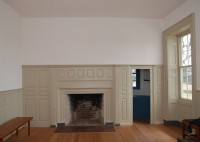 Most of the donation, $6.5 million will go to the furnishing and restoration of the mansion’s interior. The priority areas are the South Passage entry hall, James’ mother Nelly Madison’s sitting and dining rooms, several upstairs bedrooms and their closet spaces, plus the cellar kitchens and work areas.
Most of the donation, $6.5 million will go to the furnishing and restoration of the mansion’s interior. The priority areas are the South Passage entry hall, James’ mother Nelly Madison’s sitting and dining rooms, several upstairs bedrooms and their closet spaces, plus the cellar kitchens and work areas.
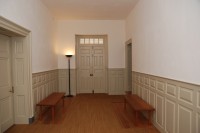 The South Hall used to be central hall of the original Georgian home from the 1760s. In Madison’s day, it was used as a secondary parlor and gallery space with an impressive array of art on the walls. It’s completely bare now, despite being the first stop on the daily tour. Nelly’s rooms are off the South Passage. The upstairs bedrooms are the Madisons’ primary bedchamber, guest and family bedchambers that once furnished will show visitors what a bustling, busy, active home it was. The closets will be stocked with linens and clothing, and the rooms furnished from bedding to seating to artwork to window treatments.
The South Hall used to be central hall of the original Georgian home from the 1760s. In Madison’s day, it was used as a secondary parlor and gallery space with an impressive array of art on the walls. It’s completely bare now, despite being the first stop on the daily tour. Nelly’s rooms are off the South Passage. The upstairs bedrooms are the Madisons’ primary bedchamber, guest and family bedchambers that once furnished will show visitors what a bustling, busy, active home it was. The closets will be stocked with linens and clothing, and the rooms furnished from bedding to seating to artwork to window treatments.
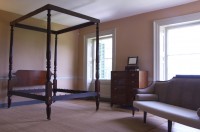 The cellar, which covers the entire footprint of the mansion, was the domain of Montpelier’s enslaved domestic staff. The space includes two kitchens, a wine cellar and multiple storage and work areas. The whole space is empty (the modern mechanical systems were moved to an underground vault during the architectural restoration). With Rubenstein’s donation, the Foundation will add interpretative elements that bring attention to the individual slaves who worked there, highlighting their personal histories and family links, their daily work on the plantation, how they traveled, their influence on Montpelier.
The cellar, which covers the entire footprint of the mansion, was the domain of Montpelier’s enslaved domestic staff. The space includes two kitchens, a wine cellar and multiple storage and work areas. The whole space is empty (the modern mechanical systems were moved to an underground vault during the architectural restoration). With Rubenstein’s donation, the Foundation will add interpretative elements that bring attention to the individual slaves who worked there, highlighting their personal histories and family links, their daily work on the plantation, how they traveled, their influence on Montpelier.
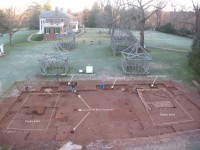 The rest of the donation, $3.5 million, will be dedicated to the reconstruction of the South Yard adjacent to the mansion. In Madison’s time, the South Yard had three duplex slave quarters (relatively comfortable housing for house slaves; the field hands lived in log and mud shacks next to the fields), two smokehouses and a detached kitchen. The kitchen, one of the duplexes and the smokehouses will be reconstructed and fully furnished to give visitors the chance to see where and how Montpelier’s enslaved community lived. The second duplex will be used as a classroom for student programs, the third for exhibition space on the slaves, field, house and skilled craftsmen, who kept Montpelier going.
The rest of the donation, $3.5 million, will be dedicated to the reconstruction of the South Yard adjacent to the mansion. In Madison’s time, the South Yard had three duplex slave quarters (relatively comfortable housing for house slaves; the field hands lived in log and mud shacks next to the fields), two smokehouses and a detached kitchen. The kitchen, one of the duplexes and the smokehouses will be reconstructed and fully furnished to give visitors the chance to see where and how Montpelier’s enslaved community lived. The second duplex will be used as a classroom for student programs, the third for exhibition space on the slaves, field, house and skilled craftsmen, who kept Montpelier going.
Rubenstein wants to help make the estate more authentic. Montpelier could draw more visitors to learn about history, he said, if the house is fully restored and its slave quarters built out. It currently draws about 125,000 visitors a year. Last year, Rubenstein gave money to recreate slave quarters on Thomas Jefferson’s plantation.
“It’s this dichotomy. You have people who were extraordinarily intelligent, well-informed, educated; they created this incredible country — Jefferson, Washington, Madison — yet they lived with this system of slavery. Jefferson, Washington and Madison all abhorred slavery, but they didn’t do, they couldn’t do, much about it,” he said. “We shouldn’t deify our Founding Fathers without recognizing that they did participate in a system that had its terrible flaws.”